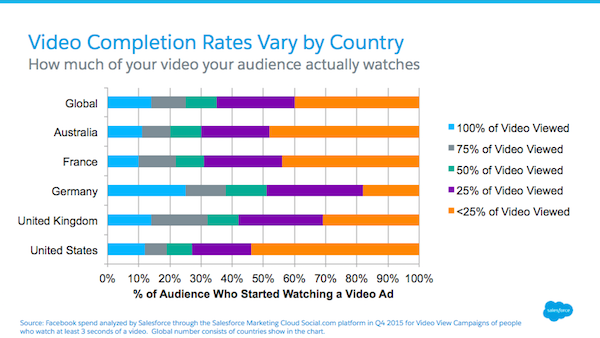
Get your FREE 30-day trial.
Please complete all fields.
Using video in your ad creative is a compelling way to tell a story or to show your newest line of products to your audience. Video advertising works for direct response, like downloading a mobile app to make online banking easier, and for brand awareness campaigns to boost brand recall or increase brand awareness and loyalty. No matter if your objective is direct response or getting more video views, Facebook gives you the metrics needed to optimize video ads. However, it's up to you as the advertiser to use those metrics to know your audience and optimize your video strategy.
Once you define your objectives and metrics for success, you need to use those metrics to optimize your audience targeting and measure the results of each video ad. Facebook allows you to measure the amount of people that watch 25%, 50%, 75%, 95%, and 100% of your video. The chart below for Facebook video view campaigns in Q4 2015 shows the percentage of video view completed by users who began watching your video.
For example, 51% of Facebook users in Germany watched at least half of a video, with 25% of users watching a full 100%. However, in the U.S. most users (54%) watch less than 25% of the video. Looking at completion rates and cost per video view at each percent interval helps demonstrate ROI of your ad spend and enables optimization of the video to align to business objective.

Before you look at video completion rates, you need to first set clear objectives because there are many different ways to use video in a campaign. Do you want more video views, or do you want your audience to take an immediate action? By using the Video View campaign objective, your video ad will be shown to people more likely to watch your video. However, if, for example, you want to drive website clicks, you should use the website click objective, with a video ad unit.
Research from Nielsen and Facebook shows that watching just three seconds of a video, how Facebook defines a video view, lifts ad recall by 47% and brand awareness by 32%. After viewing 10 second of a video, lift for those brand metrics rise to 74% and 65%, respectively. Determine your campaign objective to inform how you will optimize targeting and creative for success.
As more and more advertisers adopt video, it becomes harder to capture the attention of your audience as they are scrolling their newsfeed full of relevant content. Make each view count by creating video content that stands out from the rest. Know your audience in order to tell a story that will resonate well or to show a product they are likely interested in. You could target a Website Custom Audience with a video of a related product. Did your first video get lots of views? Target those viewers using a Video Custom Audience with a second video that continues the story! For some inspiration on video advertising, take a look at Adweek’s 24 trends that drove the best advertising.
It may be a quick win to syndicate a TV ad on Facebook, but it is better to repurpose the content to fit with the channel. When creating videos for mobile channels, focus on your visual message since most mobile videos play with sounds off and/or add captions. Additionally, you need to utilize the first 3 second of the video to establish a connection with your audience before they keep scrolling. According to Facebook, “only 65% of people who watch the first three seconds of a video will watch for at least ten seconds and 45% continue watching for thirty seconds”.
Kleenex, for example, showed its logo in the first seven seconds of its Facebook video ad that told the story of a custodial worker of a local elementary school. Even though the 2 minute and 45 second video had an average view duration of 23 seconds, this campaign resulted in a six point lift in ad recall and three point lift in purchase intent.